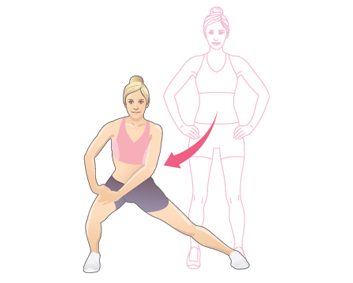
Dynamic Side Lunge
There’s nothing like warm weather to inspire some outdoor activity, whether it’s dusting off the running shoes, kicking around a soccer ball or swimming laps. But many of us forget one vital component: stretching.
“When you’re playing sports, you really need to stretch dynamically-meaning that you move with the stretch,” says Louise Chan, owner of Pura Vida Rehabilitation and Therapy, and an athletic therapist at Athlete’s Care in Toronto, who works with the Canadian Beach Volleyball team.
Technique
This side lunge stretches the adductors, and works the abductors (outer thighs) and glutes. Start with your feet shoulder-width apart, feet facing forward. Lunge to the right, bending knee to a 90-degree angle. Sink (don’t bounce) into the right side and straighten the left leg-but be careful that the right knee does not move farther forward than the toes. Place hands on the right thigh, keeping back straight, and hold for a few seconds. Straighten up and press off the right foot back to standing position. Repeat on the other side, then move side to side with the lunges five to 10 times, pausing for a few seconds each time. Do this stretch before and after your workout.
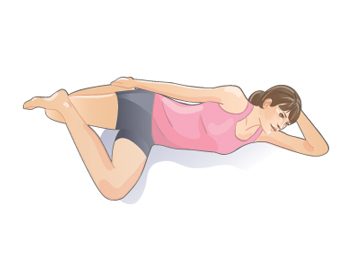
IT Band Stretch
The iliotibial (IT) band is a thick layer of connective tissue that runs along the outside of the thigh from hip to shin, attaching to the knee and helping to stabilize and move the hip and knee joints. If it is tight, it can cause major problems. When runners think they have knee issues, it might actually be a tight or inflamed IT band.
Technique
Lie on your left side. Bend your right leg back while also reaching behind to pull your right heel against your bottom. Drop right knee toward the floor. Keep your spine neutral; don’t “bounce” that leg-it should feel like a gentle pull. Next, place your left foot on top of your right knee as shown, and gently press it toward the floor. Hold for seven deep breaths. Switch sides and repeat.
If you have severe tightness, you should see a specialist to get the tissue massaged.
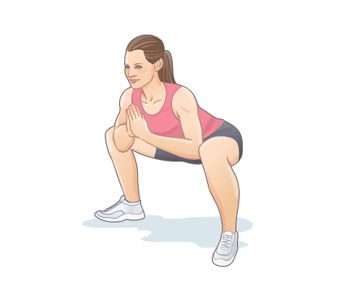
Sumo Squat
When stretching before running or walking, concentrate largely on getting the legs limber. “The Sumo Squat is fantastic because it stretches hamstrings, quads, calves and tendons in the lower leg-all in a gentle pose,” says John Stanton, founder of the Running Room and the Walking Room, and author of eight books on running. “Because the stretch is gentle, it can be done both before and after you run-as well as at stoplights. That beats running on the spot, and it will also help keep the muscles loose.”
Technique
Start with feet more than shoulder-width apart, toes angled out at 45 degrees. Bend forward at the waist, and squat so knees are bent and thighs are parallel with the floor. Place elbows between knees; press palms together. Drop hips to the ground, keeping chest lifted. Take a deep breath, and try to maintain a flat back as you push hips back, with heels on the floor, until you feel the stretch in your hamstrings and groin. Tip: To make the stretch easier, place a folded towel underneath your heels. “If you have knee problems, place a chair behind you and do hovering squats-if you lose your balance, the chair is there to catch you,” says Stanton.
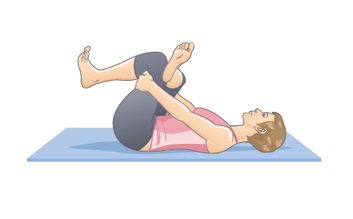
Reclining Pigeon Pose
“A lot of the time when people have knee issues, it’s not because they have weak knees, it’s because their IT band is tight,” says Mandy Ingber, a Los Angeles-based celebrity yoga and fitness instructor and the creator of the DVD Mandy Ingber’s Yogalosophy. (Jennifer Aniston is a client, and appears in the DVD’s introduction.) “This stretch will lengthen the IT band to improve your physical performance.”
Technique
Lie on your back with your knees bent and the soles of your feet on the floor. Cross your right foot over your left knee, with your right knee sticking out to the side. Keep your right foot flexed to maintain the integrity of the knee. Reach behind the hamstring on your left leg and hug it toward your chest as you open your right knee. Hold from 30 seconds to two minutes on each side depending on flexibility. Tip: Keep your head flat on the floor by tucking your chin down.
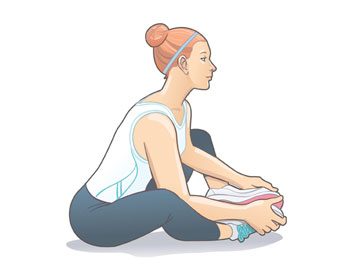
Gaga Groin Stretch
After doing lower-body exercises such as lunges and squats, remember to stretch the less developed muscles, says Toronto-born, L.A.-based celebrity trainer Harley Pasternak-not just the quads and glutes, but the inner thighs and groin, too.
Technique
Sit on the floor with your knees bent and the soles of your feet together. Keep good posture with your head up and your shoulders pulled back. Hold on to your feet and put your elbows inside your knees. Try to get your heels as close to your body as you comfortably can. Using your elbows, gently push your knees out. You will feel the stretch from inside your legs and up into your groin. Hold here for 20 to 30 seconds, recommends Pasternak.
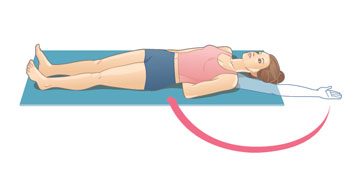
Shoulder Sweeps
Activities that have us repeatedly leaning forward, such as running, biking and even sitting at a desk, make us slouch. This move will reset your posture.
Technique
Stand against a wall so your tailbone, shoulder blades and head are all pressed against the wall. Hold your hands at shoulder level with your elbows bent at 45 degrees, and palms facing forward. Slowly extend your arms up the wall, pointing your hands as far up as they’ll go, not moving your tailbone, shoulder blades or head, and keeping them pressed against the wall. “Be slow and controlled, and try to reach as high as you can,” says Tate. Return to the starting position slowly. You should take about five to 10 seconds to reach up, and another five to 10 seconds to bring your arms back down. Repeat from eight to 12 times (if you have shoulder issues, try three to five times). “It’s surprising how challenging it can be,” says Tate. You’ll feel the stretch across your chest and shoulders, and up your back.
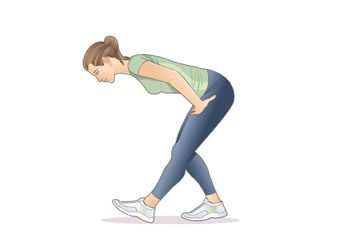
Hamstring Stretch
Olympic gold-medal-winning bobsledder, Heather Moyse recommends doing this hamstrings move after lower body activities such as walking, running or cycling.
Technique
To start, stand upright with your feet shoulder-width apart and your hands at your sides. Bring your left foot forward and lift toes off the ground. Put your hands on your thighs for balance. Bend at the waist and the right knee as you lower your body; feel the stretch through the back of your left leg. Hold here until the muscle relaxes (which is usually about 10 seconds, Moyse suggests). Stand back up and stretch the other leg the same way.
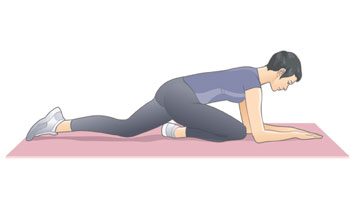
Glutes Stretch
Do this stretch after being physically active to increase flexibility and prevent pain and future injury.
Technique
Start out on all fours, with your back flat and your hands and knees shoulder-width apart. Bring your left knee to the left hand and your left ankle up and toward your right hip. As you do that, extend your right leg so your thigh is close to the floor as you drop your hips and rest on your forearms. “Breathe deeply, and always keep your back and neck aligned,” says Bowie. Hold the stretch for a minimum of 20 seconds. Try to do this up to three times with each leg.
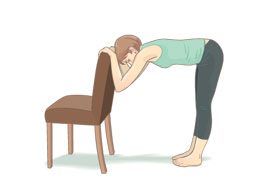
Hamstring Stretch with Chair
“Your muscles tighten when you exercise,” says Gidon Gabbay, a personal trainer and the owner of G Force Home Training in Toronto.
“Stretching lengthens muscles and helps with repair, so you won’t feel sore the next day.”
Technique
Position yourself about a foot and a half (half a metre) behind a chair. Stand up straight, with your shoulders back and feet pointing forward. Keep your knees straight, but not locked. Keeping your neck aligned with your back throughout this move, bend at the hips to a 90-degree angle. “Don’t round your back,” says Gabbay. “Put your weight onto your hands.” (You may need to move the chair forward so you are putting the weight of your body on the chair and not holding yourself up-you’ll feel the stretch more this way.) Hold for 30 seconds.
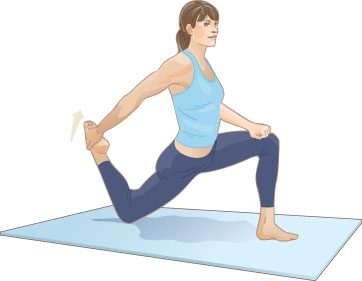
Lunge Quad Stretch
Try this move to stretch your gluteal (butt), quadriceps (fronts of thighs) and calf muscles.
Technique
Step forward with your left foot and lunge down, so your left thigh is parallel to the floor. Hold for 20 seconds. Rest your back (right) knee on the floor and grasp your right foot with your right hand. If you need to, rest your left hand on a wall for balance. Hold for 20 seconds. Repeat on the other side. “It’s important to stay upright with an open chest,” says Faber. “You don’t want to be hunched over. You want your shoulders back and down.” Give it a go!
